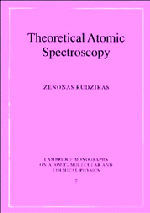Book contents
- Frontmatter
- Contents
- Preface
- Foreword to the Paperback Edition
- Introduction
- Part 1 Energy Spectrum of Many-electron Atom. Radiative and Autoionizing Transitions (Initial Formulas)
- Part 2 Foundations of the Angular Momentum Theory. Graphical Methods
- Part 3 Description of Complex Electronic Configurations
- Part 4 Second-quantization in the Theory of an Atom. Quasispin and Isospin
- Part 5 Matrix Elements of the Energy Operator
- 19 The energy of a shell of equivalent electrons
- 20 Interaction energy of two shells in LS coupling
- 21 Semi-empirical methods of calculation of the energy spectra
- 22 Hyperfine structure of the energy spectra, isotopic and Lamb shift
- 23 Quasispin and isospin for relativistic matrix elements
- Part 6 Electric and Magnetic Multipole Transitions
- Part 7 Calculation of Energy Spectra and Electronic Transitions in the Case of Complex Configurations
- Epilogue
- References
- Index
20 - Interaction energy of two shells in LS coupling
Published online by Cambridge University Press: 21 September 2009
- Frontmatter
- Contents
- Preface
- Foreword to the Paperback Edition
- Introduction
- Part 1 Energy Spectrum of Many-electron Atom. Radiative and Autoionizing Transitions (Initial Formulas)
- Part 2 Foundations of the Angular Momentum Theory. Graphical Methods
- Part 3 Description of Complex Electronic Configurations
- Part 4 Second-quantization in the Theory of an Atom. Quasispin and Isospin
- Part 5 Matrix Elements of the Energy Operator
- 19 The energy of a shell of equivalent electrons
- 20 Interaction energy of two shells in LS coupling
- 21 Semi-empirical methods of calculation of the energy spectra
- 22 Hyperfine structure of the energy spectra, isotopic and Lamb shift
- 23 Quasispin and isospin for relativistic matrix elements
- Part 6 Electric and Magnetic Multipole Transitions
- Part 7 Calculation of Energy Spectra and Electronic Transitions in the Case of Complex Configurations
- Epilogue
- References
- Index
Summary
While studying the energy spectra or other spectral quantities of atoms and ions having complex electronic configurations, one ought to consider the expressions for the matrix elements of the operators both within each shell of equivalent electrons and between each pair of these shells. For example, in order to find the energy spectrum of the ground configuration 1s22s2 of the beryllium atom, we have to calculate the interaction energy in each shell ls2 and 2s2 as well as between them. The last case will be discussed in this chapter. If there are more shells, then according to the two-particle character of interelectronic interactions, we have to account for this interaction between all possible pairs of shells.
Let us notice that momenta of each shell may be coupled into total momenta by various coupling schemes. Therefore, here, as in the case of two non-equivalent electrons, coupling schemes (11.2)–(11.5) are possible, only instead of one-electronic momenta there will be the total momenta of separate shells. To indicate this we shall use the notation LS, LK, JK and JJ. Some peculiarities of their usage were discussed in Chapters 11 and 12 and will be additionally considered in Chapter 30. Therefore, here we shall restrict ourselves to the case of LS coupling for non-relativistic and JJ (or jj) coupling for relativistic wave functions. We shall not indicate explicitly the parity of the configuration, consisting of several shells, because it is simply equal to the sum of parities of all shells.
- Type
- Chapter
- Information
- Theoretical Atomic Spectroscopy , pp. 235 - 247Publisher: Cambridge University PressPrint publication year: 1997



